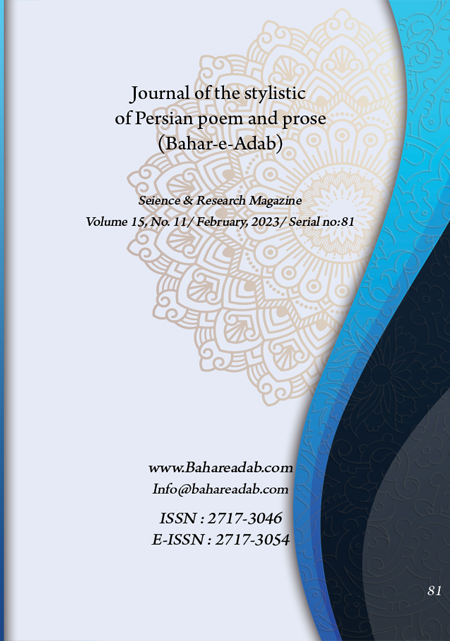- Count View : 281
- آدرس کوتاه شده مقاله: https://bahareadab.com/article_id/1401
- کد doi مقاله: Doi: 10.22034/bahareadab.2023 .15 .6749
Journal of the stylistic of Persian poem and prose
volume Number 15،
number In Volume 11،
،
issue Number 81
A study of the stylistics of Simindokht Vahidi's poems
Akram Jahangirian , Manijeh Fallahi (Author in Charge), Reza Fahimi
Abstract
BACKGROUND AND OBJECTIVES: Simindokht Vahidi is one of the poets of the Islamic Revolution who has experimented with nature in various formats.
METHODOLOGY: The article has been done with library studies and has been written in a descriptive-analytical method by selecting poetry samples. The statistical population of the research is the book "Poetry Divan" by the poet.
FINDINGS: Vahidi"s poems at the linguistic level, in external and lateral music, are in accordance with the common prosody and rhyme of Persian poetry. Only in some cases in Masnavi, in line with the weight changes of Masnavi after the revolution, it has used high weights. With his emotional tone, intimacy of speech, simple and short sentences, he has brought his language closer to the feminine language on a lexical and syntactic level. At the literary level, detailed similes, metaphorical addition, and discernment are more common than imaginary. At the intellectual level, the content of his poems includes the themes of stability by describing war, calling for stability, describing martyrs, warriors, Basijis, Muslims of the world, and religious themes in the form of mourning and mourning for the Imams. These two themes are characteristic of the poet"s intellectual style.
CONCLUSION: Vahidi is a poet committed to the ideals of revolution and holy defense, who with simple language, emotional tone and intimacy of speech, short sentences, words free from the proportion of feminine language, with words mixed with various literary arrays, by changing the content of classical forms in the intellectual style of stability, religious, mystical poetry has been written. In the mystical subject of the descent of man, he advises not to be attached to the world and condemns secularism and egoism. On social issues, he is a critic of a patriarchal society and has praised the status of women and mothers.
Keyword
Simindokht Vahidi
, Stylistics
, Poetry Divan
, Language
, Aesthetics
, Thought
- Akbari, Manouchehr. (1992). Critique and Analysis of the Literature of the Islamic Revolution, Volume 1, Tehran: Organization of Cultural Documents of the Islamic Revolution.
- Fayyazmanesh, Parand. (2002). "Study of themes, themes and forms of war poetry", Persian Language and Literature Research Quarterly, Vol. 1, pp. 128-113.
- Fotouhi, Mahmoud. (2011). Stylistics, Theories, Approaches and Methods, Tehran: Sokhan.
- Kafi, Gholamreza. (1998). "Watching the Blessed Wounds, A Look at the Evolution of the Poetry Style of the Islamic Revolution", Collection of Articles on Revolutionary Literature and Literary Revolution, Volume 1, Tehran: Imam Khomeini Publishing House.
- Mokhtari, Qasem & Derakhshan, Masoumeh. (2015). "A Comparative Study of Linguistic and Intellectual Style and Analysis of Gender Language in the Poems of Parvin Etesami and Nazak Al-Malaika" Journal of Comparative Literature (Arabic-Persian Comparative Studies), No. 17, pp. 105-125.
- Pourolkhas, Shokrollah, Sadeghi, Mehdi. (2011). "Structural Critique of the Masnavi of the Revolution", Quarterly Journal of Persian Poetry, No.4, pp. 95-79.
- Sha’iri, Hamidreza & Torabi, Bita. (2012). "Study of production conditions and receiving meaning in discourse communication" Al-Zahra University Linguistics Quarterly, Vol. 6, pp. 23-49.
- Shamisa, Sirus. (1999). Generalities of Stylistics, Tehran: Ferdows.
- Vahidi, Simindokht. (1981). "The Transformation that the Revolution Created in Art", Interview with Vahidi, Jahad Magazine, No. 28, pp. 38-39.
- Vahidi, Simindokht. (2011). Poetry Divan, Tehran: Iranian Pen Association.
- Zarghani, Mehdi. (2012). The Perspective of Contemporary Iranian Poetry: The Flow of Iranian Poetry in the Twentieth Century, Tehran: Sales.

